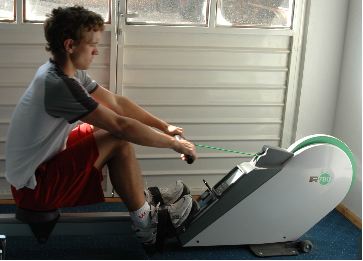 These machines are smooth-running, and work on the principle that the faster you go, the more work you do, therefore the greater the training effect. Most have computer-controlled readings of distance travelled, work done, time spent, and sometimes the user can also monitor heart rate. Machines with this kind of feedback are called ergometers.
These machines are smooth-running, and work on the principle that the faster you go, the more work you do, therefore the greater the training effect. Most have computer-controlled readings of distance travelled, work done, time spent, and sometimes the user can also monitor heart rate. Machines with this kind of feedback are called ergometers.
Main muscles worked: The lower back extensor muscles, hip and knee extensors (gluteals and front-thigh muscles), hamstrings (but less), calves, shoulder girdle retractors (trapezius, rhomboids), shoulder extensors and (less) flexors, elbow flexors and (less) extensors, forearm and wrist extensors, finger flexors.
The rowing machine is an aerobic exercise, and is good for aerobic training for the heart, lungs and working muscles, if you do it fairly fast over a space of about 20 minutes. You can do the session in one go, or split into sections of, say, five minutes repeated within an overall training session involving other exercises done at speed.
You can row for longer if you wish, for instance if you are training for a long distance event and want to build up the endurance of your muscles.
Preparation: Sit on the seat, making sure that your shirt or sweater is tucked in (otherwise it can get caught under the sliding seat). Place your feet in the foot rests, and fasten the straps comfortably.
Starting position: Keeping your back as straight as possible, bend your knees to glide forwards, and take hold of the bar with your hands, keeping your elbows straight.
Action: Straighten your knees as you draw your hands towards your stomach region, leaning slightly backwards with your trunk as you pull your hands into your body. Reverse the movement starting with your hands by extending your wrists (so the fingers go upwards); straighten your elbows so your hands pass over your thighs. When your hands have gone just past your knees, bend the knees so that you return to the starting position.
Caution: Avoid pain. If you have had a back or knee problem, you may find that the rowing machine causes pain, so you should not do it. Do not do aerobic exercise if you have any kind of infection, or are suffering from headaches, dizziness or light-headedness. Pay attention to technique, in particular having your knees more or less straight as your hands pass over them in each direction. use your legs: bend your knees fully as you come to the forward position, and don’t over-stretch your back and shoulder girdle by trying to reach too far forward.
© Vivian Grisogono 2008


